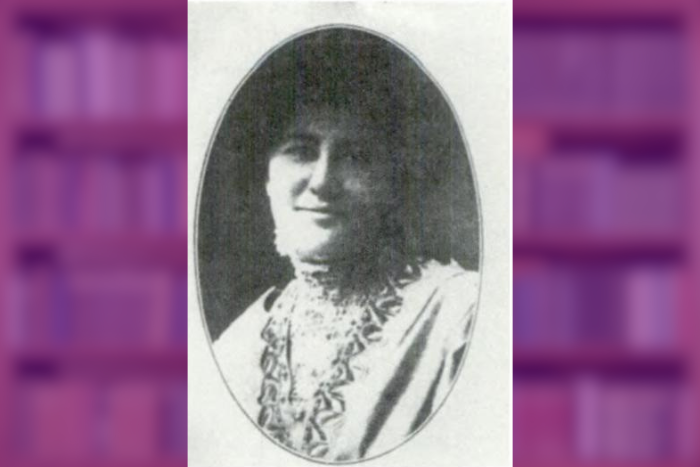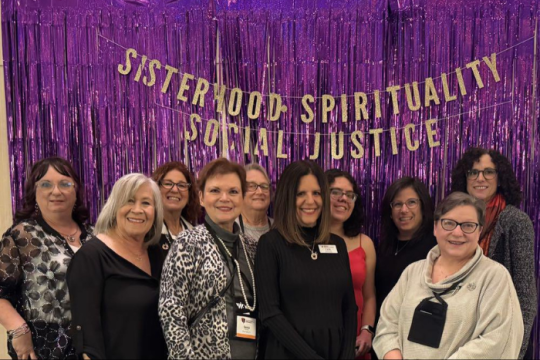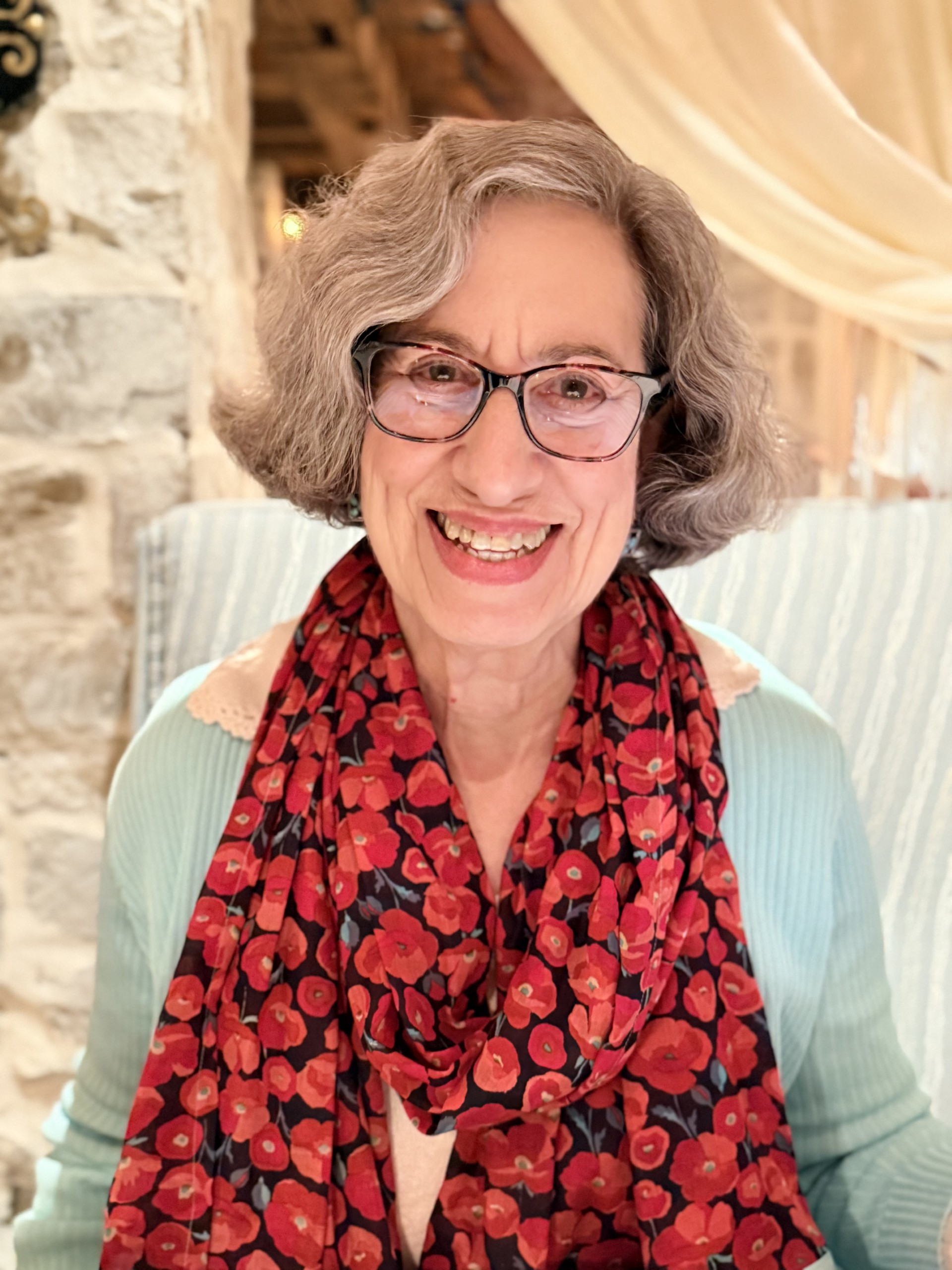
Jeannette Miriam Goldberg. Photo from American Hebrew, September 10, 1915, reproduced courtesy of The Jacob Rader Marcus Center of the American Jewish Archives, Cincinnati, Ohio. Pulled from digital version of "'Junior League': The Rise and Demise of the Fort Worth Council of Jewish Women" by Hollace A. Weiner, page 29.
“People called her ‘Jeannette Miriam.’ She was a spitfire. She was a proto-feminist, an attractive, sociable, smart woman in leadership positions before women got the vote. What a role model then and now.” — Hollace Ava Weiner
The Atlantic District is unique among the Women of Reform Judaism (WRJ) districts in having a 90-year-old philanthropic fund, the Jeannette Miriam Goldberg Youth Fund, named after a well-known, much-admired woman. Who was she, why was the fund named for her, and how did I find out about her?
When I joined the district board, I knew nothing about the fund, having seen its name only in an easily ignored annual fundraising request. The board tried to encourage donations — the fund’s sole support — by designing a card to be sent on a donor’s behalf and by publicizing that the fund supports the local National Federation of Temple Youth (NFTY) region. I thought that knowing more about the woman herself would help increase donations.
The district website says only, “Jeannette Miriam Goldberg z”l, an active PFTS member, from Temple Rodeph Shalom Sisterhood, Philadelphia, had passed away. During her lifetime, Miss Goldberg had been greatly concerned with the welfare of Jewish youth.”
The internet revealed that she was born in Jefferson, Texas in 1868, worked for the National Council of Jewish Women (NCJW), and came to Philadelphia in 1905 as field secretary of the Jewish Chautauqua Society (JCS). She became JCS executive secretary in 1910 until her sudden death in 1935. Goldberg was widely known as a Jewish educator and mourned nationally when she died.
I first emailed the NCJW. They had no information about her but referred me to Pamela Nadell, author of America’s Jewish Women: A History from Colonial Times to Today. She suggested contacting Hollace Ava Weiner.
Hollace, a historian, director of the Fort Worth Jewish Archives, and WRJ member, knew about Goldberg’s early life because of her book about Jewish women’s groups in late 19th century Texas. When she learned that I wanted to make Goldberg more widely known, she wrote short articles for two historical societies with which she is affiliated, highlighting that our fund is the only remaining memorial to Goldberg and including information on how to donate.
Upon reading Hollace’s description, above, I wanted to know more about ‘Jeannette Miriam.’ I learned that she followed a path in her personal and professional lives that was unusual for the times in which she lived. She was a self-supporting single career woman in a high-pressure job who still found time for volunteer activities, locally and nationally.
The JCS came under the sponsorship of Men of Reform Judaism (MRJ) in 1939, so I contacted them to find out more about Goldberg’s JCS work. Ironically, it was through MRJ that I learned of her National Federation of Temple Sisterhoods (NFTS) board service and membership.
Now I knew what records to consult. NFTS documents were digitized through 1955 at the American Jewish Archives (AJA) in Cincinnati; I was able to access them from home. JCS minutes are available in-person at the Archives, but they are not digitized so I needed an archivist’s help. I learned there are old synagogue records at Temple University and old Jewish Exponent issues are on microfilm at the Free Library of Philadelphia; I went to see both.
The JCS, founded in 1893 by Rabbi Henry Berkowitz of Philadelphia’s Congregation Rodeph Shalom, popularized Jewish learning among Jews and non-Jews through reading circles and lectures. He praised her: “Miss Goldberg … visited more cities, towns, villages and hamlets, addressed more gatherings of Jewish people, … [organized] more reading circles and religious schools and ... more Jewish congregations than has any other man or woman in America. The friends she has made are legion and her extraordinary memory is matched only by the generous impulses of her heart and by her self-sacrificing spirit.”
In Philadelphia, she joined Rodeph Shalom; in 1913, its women’s auxiliary became a sisterhood and an NFTS member. Goldberg was the first sisterhood president from 1913 to 1915 and again from 1927 to 1931. She was appointed to the synagogue board in 1927, worked extensively with the youth group, and served until her death.
Goldberg attended several NFTS biennials; the first in 1915, the third in 1919, and the fourth in 1921. She was on various committees and served on the 1919 and 1921 boards. For unknown reasons she did not attend the fifth (1923) or sixth (1925) biennials, nor served on those boards. At the Seventh Biennial in 1927, she was appointed to the board for a six-year term spanning 1929 to 1935. As the chair of the Committee on State Federations, she presided over meetings of state federation presidents at the biennials and traveled to attend meetings of some state federations and local sisterhoods.
Goldberg was the first unmarried board member. Until at least the Twentieth Biennial in 1955, women were referred to by their husband’s name. Goldberg stood out because she was listed under her own name. Board size steadily increased, yet she was either the only single woman or one of two. The number never exceeded two through 1955.
We don’t know what Goldberg thought about her life or if she realized the impact she had on others. Her personality is so strong that it comes through in her short reports and the Welcoming Speech, which she gave at the Ninth Biennial (1931) in Philadelphia. The sentiment and spirit of her words seem remarkably familiar. Her passion for and dedication to her cause is evident.
In her report for the Eleventh Biennial in March of 1935, delivered posthumously by her vice-chair, she said:
“My years … as National Chairman on State Federations have been a source of great pleasure to me and I have experienced but one difficulty; namely that it has not been easy to awaken the officers to the necessity of promptly sending reports of their State meetings to the National Office ... It has only been through persistent effort that we have received … the list of new officers, etc.
It is my hope that … all of us together go onward and forward and the end crown the work in the interest of organized womanhood and American Jewish Life.”
Goldberg died suddenly on February 28, 1935. She was buried on March 3, 1935 in the still-existing family mausoleum at Mount Sinai Cemetery in Jefferson, Texas. Mourners, flowers, and telegrams came from all over the country upon her passing, an event unprecedented in Jefferson’s history.
Her death led to an outpouring of grief and praise. NFTS and JCS wrote memorial resolutions. Congregation Rodeph Shalom, its sisterhood and youth group, the Camp Council of Philadelphia, Eagleville Sanatorium, and Rabbi William Rosenau (a retired JCS vice chancellor) published tributes in the Jewish Exponent. A plaque may have been placed in the Hebrew Sinai Congregation in Jefferson. My quest to confirm its origins and existence was unsuccessful, despite much help from Julianne Fischer of the Jefferson Historical Society.
Goldberg was lauded as an inspiration, a guiding light, and a blessing to the Jewish community. She was praised for her thirty-year career at JCS, her volunteer work in her sisterhood and NFTS, at Eagleville Sanatorium, and with young people at Rodeph Shalom and the Camp Council of Philadelphia. She was loved, admired, and deeply mourned. The tributes are so glowing that it is a wonder that Goldberg is not better known today.
Memorials were established, too. Hebrew Union College created a lecture series in her memory funded by the JCS through 1949. The Camp Council of Philadelphia started, but did not continue, a fund in her honor. Camp Harlam supposedly built the Jeannette Miriam Goldberg Faculty House in 1960 with help from the Pennsylvania Federation of Temple Sisterhoods (PFTS). Rosanne Selfon, a WRJ North American and Atlantic District past president, contacted her network of camp supporters, but no one has ever heard of the building’s existence.
The most important memorial was created in 1936. Since 1929, PFTS aided Jewish students at Penn State College in several ways. Shortly before Goldberg’s death, these ad hoc efforts became an ongoing loan fund. PFTS wanted to memorialize Goldberg and named the fund for her. Various NFTS Biennial Proceedings and Annual Reports noted the PFTS efforts. The 1946 Annual Report said: "This Federation [Pennsylvania] sponsors the Jeannette Miriam Goldberg Scholarship Fund, commemorating the many noble pursuits of this Jewish Woman who devoted her life to education, Jewish and secular."
Eventually the loan fund was no longer needed, and the money went to Camp Harlam. Later, the fund supported the Pennsylvania Federation of Temple Youth, now the Pennsylvania Area Region. Since 2006, when the Pennsylvania and New Jersey districts merged to become the Atlantic District, NFTY members of the entire district benefited.
Though there have been many tributes and legacies to this remarkable woman, the most enduring memorial to Miss Jeannette Miriam Goldberg is WRJ Atlantic District’s own Jeannette Miriam Goldberg Youth Fund. Let us work to keep it alive!
For the full paper, including details, acknowledgements, endnotes, and sources, please visit the "Who We Are" section of the Atlantic District website.
Related Posts

"Hungry for More"

Yearning for Something Different


